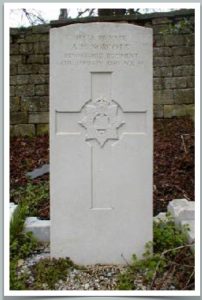2nd Battalion, Devonshire Regiment

Arthur Henry Norcott was born at Stonehouse, on 1 May 1878.
He was the son of Charles and Ellen (née Andrews), and one of three children — a brother, Charles Daniel was born in 1880 and a sister, Annie Louisa, in 1875.
His early life appears to have been one of sadness; his father died in 1880 (age 31) and his mother in 1884 (age 32). His sister was to die in 1890.
The 1881 Census records him, at the age of two, living with his grandparents and that of 1891 records him as a scholar at District Mullers Orphan House No 4 in Bristol.
By the 1901 Census he had moved across the country to Moulton in Suffolk where he was employed as a gardener.
On 2 March 1905, aged 27, he married Theresa Adams, at the Parish Church in Woodchester and at the time of the 1911 Census the couple were living in Burley Street, Burley, near Ringwood in Hampshire, where Arthur was employed as a domestic gardener.
By the time of that census they had had twin boys Rupert Arthur and Charles Alexander (then aged 5) and a girl, Millicent Ida, aged 4.
It is believed that Arthur enlisted at Ringwood, probably sometime in 1915: unfortunately, his Army Service Record appears to be one of those destroyed during the Blitz on London in 1940.
However, his Medal Index Card, held at the National Archives, does show him as originally serving with the Hampshire Regiment (with number 26272), before a transfer to the 8th Battalion of the Devonshire Regiment and thereafter their 2nd Battalion.
The transfer between regiments may indicate a return to the Front, following a period of convalescence or a wound, to fill a gap caused by casualties but in the absence of any record papers we cannot be sure.
According to the Western Times of 11 June 1918 he was a prisoner of war. Recently released records of the International Committee for the Red Cross (ICRC) in Switzerland confirm that he was repatriated from Germany on 2 June 1918, to King George Hospital, Stamford Street, London SE2.
He was suffering from a gun shot wound in his right thigh. Details supplied to the ICRC by the German Army indicate that he was captured at Zonnebeke (near Ypres) on 16 August 1917, whilst serving with ‘C’ Company, 2nd Devons.
He was sent to a hospital in Dortmund, which was under the control of Munster 3 Prisoner of War Camp.
The War Diary for the 2nd Devons which were part of 23 Brigade, 8 Division (National Archive reference WO95/1712/2) indicates that on 16 August 1917 ‘C’ Company battalion attacked German positions, in support of the 2nd Middlesex. This was near to a railway line on Westhoek Ridge (near to Zonnebeke).
The attack was partially successful but in the latter stages the advancing troops were subjected to hostile machine gun fire which forced the 2nd Middlesex to withdraw aided by the Devons provided covering fire with both rifles and machine guns. A large number of the enemy were claimed as killed.
The War Diary does not mention a figure for ‘C’ Company casualties, however Soldiers Died in the Great War lists 22 killed on either the 16th or 17th August.
No doubt there were many more injured, of which Private Arthur Norcott was probably one.
It seems likely that Arthur never recovered from his severe wounds and having arrived back in London, as a result of an exchange of wounded men, he was transferred to the Royal Victoria Hospital, Netley, near Southampton, to be nearer to his home and to enable his family to visit.
He died there on 4 January 1920, aged 41 and was taken back to Stonehouse, for burial in St Cyr’s Churchyard, where a standard CWGC headstone now marks his grave.
Researched by Graham Adams 12 December 2017
